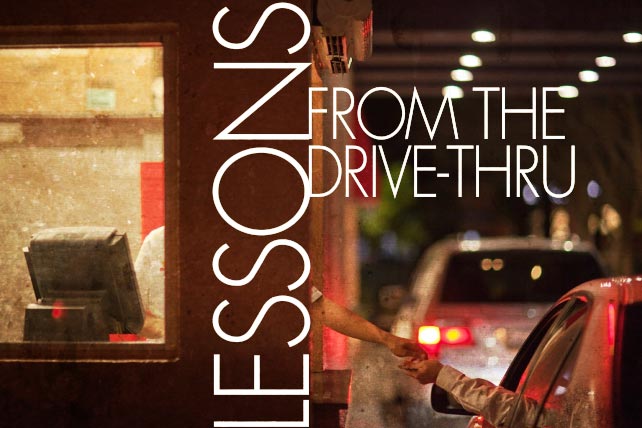Churches and drive-thru fast-food restaurants seem to have little to no comparative value, until you look at the common denominator of both: the customer (people). Of course, I’m not saying the local church is selling anything to people, but I am provoking a perspective that says the people who are customers of a fast-food chain are the same people who are attending our churches.
Lesson #1: Minimum information, maximum call-to-action
Unless you order a meal or item as-is from any fast-food drive up, there’s a high likelihood that your order will be incorrect. Likewise, unless you create a valuable call-to-action that is framed around the default expectations of your members and attendees, there’s a high likelihood that people won’t get involved.
My personal experience has taught me that if I want a burger with only a couple of things on it, it’s easier to say “plain, but add lettuce and pickles,” than to tell them what I do not want on my burger. The reason is simple: There’s a button for “plain” and a button for “add.” This is much easier on the employee than making them put in the regular order then start subtracting what I don’t want and then finally adding something I do want. Frankly, it confuses them.
Similarly, there’s great simplicity in the truth that “less is more.” Rather than giving all the details at once about a service, activity or event, and then listing all of the unique qualifiers and exceptions, it’s much more effective to summate the big idea with a simple qualifier statement and an easy to respond/act/sign-up immediately option. And, while you’re at it, it’s best to limit opportunities presented to just one. Don’t spam the people with irrelevant information, but instead respect their time and bandwidth with specific, valuable, actionable information that leads to an opportunity for relational connectedness with your ministry team.
Lesson #2: Less is more
Know thy audience. I’ve never understood why KFC, Long John Silvers and Taco Bell would ever co-exist in a single location. Look, I get it that Yum! (the parent company) sees an opportunity to meet a family’s unique tastes from a single drive-thru window, but I cannot and would not ever consider going inside to eat; the olfactory assault of non-complementary food lingering in the air would instantly kill my appetite. Perhaps this strategy will work in a drive-thru line (though I doubt it would be fast—see Lesson #3 below), but it does not work when churches try to pack everything into a single communication distribution channel.
In-N-Out Burger has this figured out, and they cook with fresh ingredients, not frozen, so their prep time takes longer yet their drive-thru is fast.
The people that need to know about how to register for the single adult night of bowling are not the same group that will need to attend the youth lock-in, nor are they the same group that care much about a marriage seminar. And yet churches send out all-in-one communications.
When you communicate everything to everyone, you reach no one.
Lesson #3: Communicate value, not need
Depending on the type of message you want to share, organize my choices into simple, obvious groupings. The fast food menu for most establishments is now an oxymoron. There is simply no way for a fast decision to be made when the volume of choices rival that of the Cheesecake Factory (a bloated menu of seemingly endless choices, for those unfamiliar with the popular restaurant).
A general rule of thumb in communicating information to people is to think about what you say from at least one of three methods:
“Entertain me!”—through clever and/or funny media, engage the user to identify with what you’re offering through a positive association or experience.
“Help me!”—via thought leadership, provide credible authority/expertise with solutions about a subject/topic.
“Love me!”—generate loyal, fanatic advocates who love you, love what you represent and enthusiastically share with their friends.
Paraphrasing the Apostle Paul, the greatest of these three is love. It’s important to note that the third option almost never exists in mass communication efforts. Love is relational, and relationships require personal connection. Handwritten notes (yes, those still exist), a phone call, a personal text, a mention on Facebook or a direct message on Twitter, or even a personal email, are all very effective methods of creating personal connection, personal activation and personal commitment. When you love people genuinely and well, they’ll get involved and get others involved, too.
What lessons would you add to this list? And, what’s been your experience with your church’s communication?













